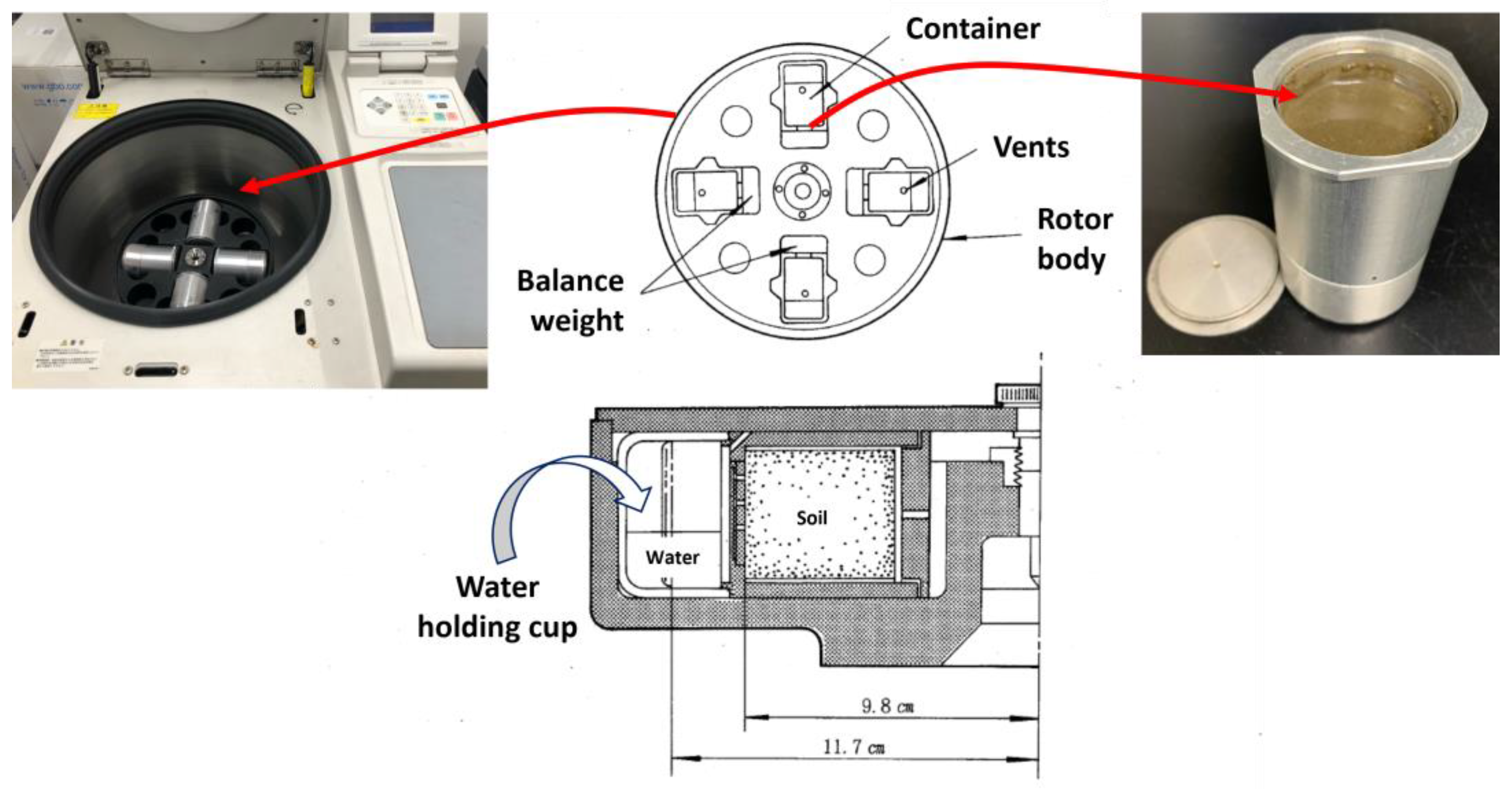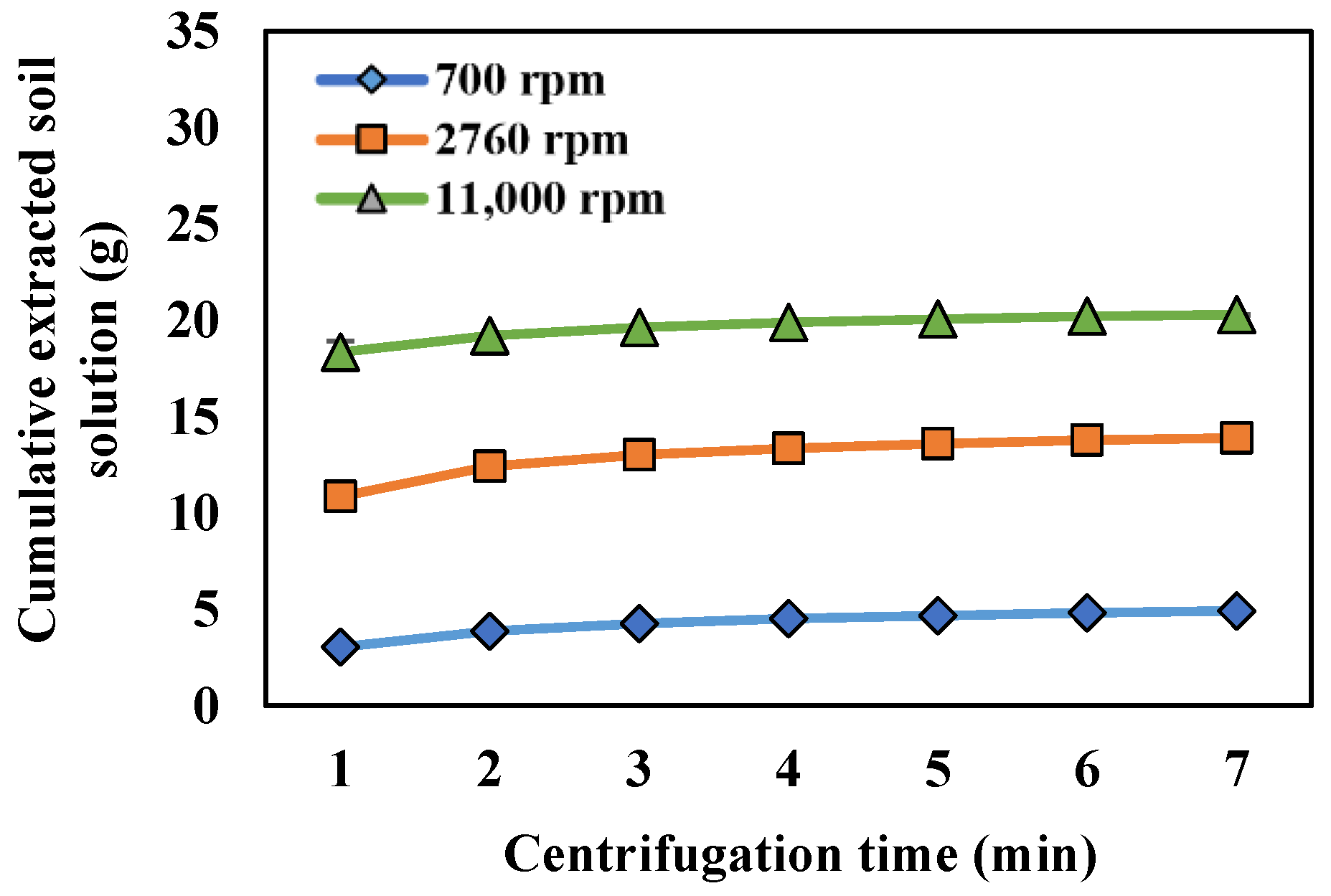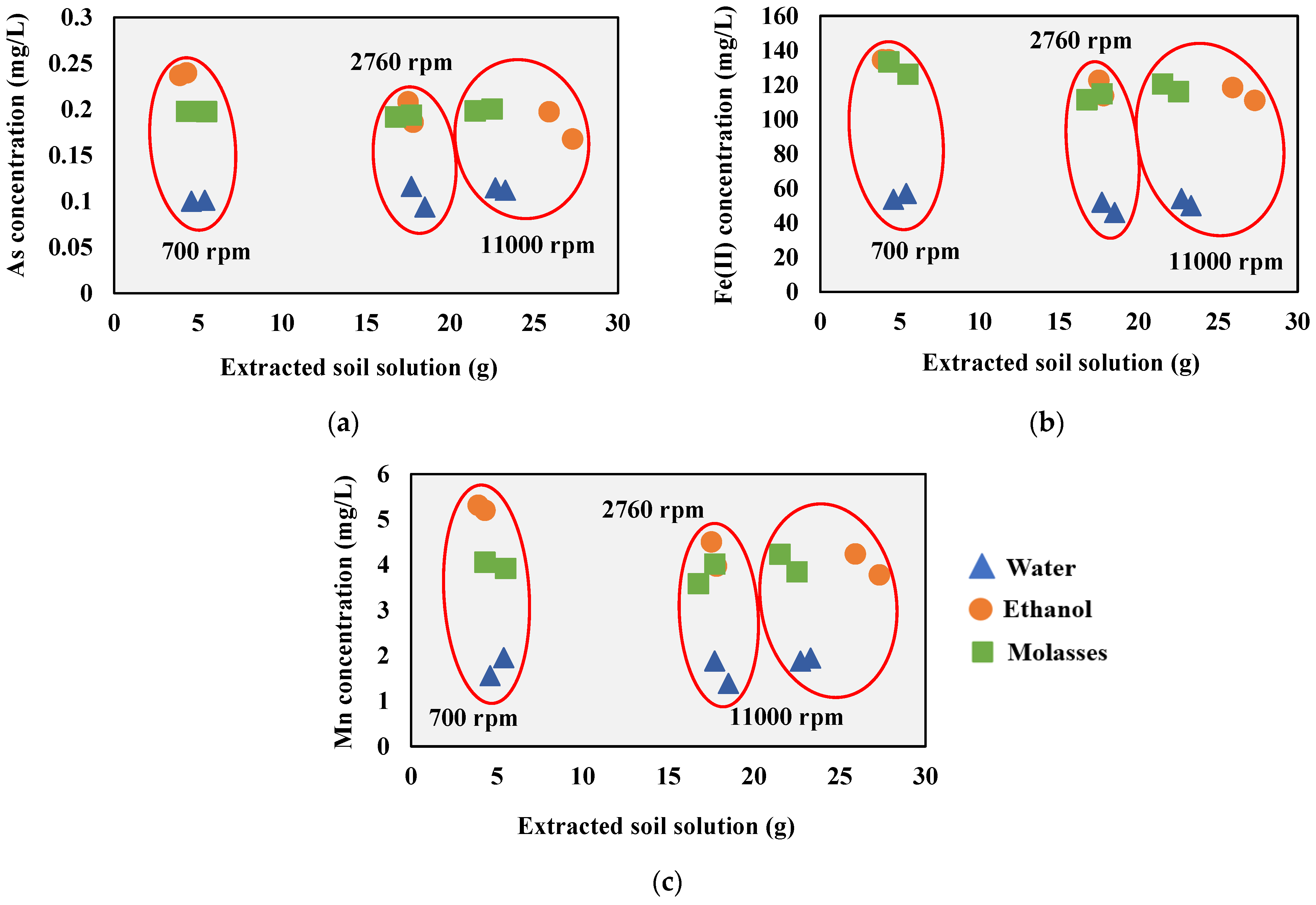Verification of the Solid–Liquid Separation of Waterlogged Reduced Soil via a Centrifugal Filtration Method
Abstract
1. Introduction
2. Materials and Methods
2.1. Soil
2.2. Analysis of Soil Physicochemical Properties
2.3. Incubation Experiments
2.4. Solid–Liquid Separation by CFM
2.5. Analysis of Soil Solution
2.6. Statistical Analysis
3. Results
3.1. Soil Properties
3.2. Changes in Soil pH and Eh during Incubation Experiments
3.3. Behavior of Solutes (Metals) during Incubation Experiments
3.4. Effects of Centrifugation Time and Speed on Soil Solution Extraction
3.5. Solute Concentrations in CFM-Extracted Soil Solutions
4. Discussion
5. Conclusions
Author Contributions
Funding
Institutional Review Board Statement
Informed Consent Statement
Data Availability Statement
Acknowledgments
Conflicts of Interest
References
- Dahlgren, R.A. Comparison of soil solution extraction procedures: Effect on solute chemistry. Commun. Soil Sci. Plant Anal. 1993, 24, 1783–1794. [Google Scholar] [CrossRef]
- Geibe, C.E.; Danielsson, R.; van Hees, P.A.W.; Lundström, U.S. Comparison of soil solution chemistry samples by centrifugation, two types of suction lysimeters and zero-tension lysimeters. Appl. Geochem. 2006, 21, 2096–2111. [Google Scholar] [CrossRef]
- Elkhatib, E.A.; Hern, J.L.; Staley, T.E. A rapid centrifugation method for obtaining soil solution. Soil Sci. Soc. Am. J. 1987, 51, 578–583. [Google Scholar] [CrossRef]
- Fraters, D.; Boom, G.J.F.L.; Boumans, L.J.M.; de Weerd, H.; Wolters, M. Extraction of soil solution by drainage centrifugation- effects of centrifugal force and time of centrifugation on soil moisture recovery and solute concentrations in soil moisture of loess subsoils. Environ. Monit. Assess. 2017, 189, 83. [Google Scholar] [CrossRef] [PubMed]
- Grossmann, J.; Udluft, P. The extraction of soil water by the suction-cup method: A review. Eur. J. Soil Sci. 1991, 42, 83–93. [Google Scholar] [CrossRef]
- Presley, B.J.; Brooks, R.R.; Kappel, H.M. A simple squeezer for removal of interstitial water from ocean sediments. J. Mar. Sci. 1967, 25, 355–357. [Google Scholar]
- Moore, J.N.; Ficklin, W.H.; Johns, C. Partitioning of arsenic and metals in reducing sulfidic sediments. Environ. Sci. Technol. 1988, 22, 432–437. [Google Scholar] [CrossRef]
- Fageria, N.K.; Carvalho, G.D.; Santos, A.B.; Ferreira, E.P.B.; Knupp, A.M. Chemistry of lowland rice soils and nutrient availability. Commun. Soil Sci. Plant Anal. 2011, 42, 1913–1933. [Google Scholar] [CrossRef]
- Burton, E.D.; Johnston, S.G.; Kocar, B.D. Arsenic mobility during flooding of contaminated soil: The effect of microbial sulfate reduction. Environ. Sci. Technol. 2014, 48, 13660–13667. [Google Scholar] [CrossRef] [PubMed]
- Hussain, M.M.; Bibi, I.; Niazi, N.K.; Shahid, M.; Iqbal, J.; Shakoor, M.B.; Ahmad, A.; Shah, N.S.; Bhattacharya, P.; Mao, K.; et al. Arsenic biogeochemical cycling in paddy soil-rice system: Interaction with various factors, amendments and mineral nutrients. Sci. Total Environ. 2021, 773, 145040. [Google Scholar] [CrossRef]
- Kwon, J.C.; Nejad, Z.D.; Jung, M.C. Arsenic and heavy metals in paddy soil and polished rice contaminated by mining activities in Korea. Catena 2017, 148, 92–100. [Google Scholar] [CrossRef]
- Gee, G.W.; Bauder, J.W. Particle-size analysis. In Methods of Soil Analysis: Part 1 Physical and Mineralogical Methods, 2nd ed.; Arnold, K., Ed.; Soil Science Society of America: Madison, WI, USA, 1986; pp. 383–411. [Google Scholar]
- Makino, T.; Sugahara, K.; Sakurai, Y.; Takano, H.; Kamiya, T.; Sasaki, K.; Itou, T.; Sekiya, N. Remediation of cadmium contamination in paddy soils by washing with chemicals: Selection of washing chemicals. Environ. Pollut. 2006, 144, 2–10. [Google Scholar] [CrossRef] [PubMed]
- He, Y.; DeSutter, T.; Prunty, L.; Hopkins, D.; Jia, X.; Wysocki, D.A. Evaluation of 1:5 soil to water extract electrical conductivity methods. Geoderma 2012, 185–186, 12–17. [Google Scholar] [CrossRef]
- Summer, M.E.; Miller, W.P. Cation exchange capacity and exchange coefficients. In Methods of Soil Analysis: Part 3 Chemical Methods; Sparks, D.L., Ed.; Soil Science Society of America: Madison, WI, USA, 1996; pp. 1201–1229. [Google Scholar]
- Olsen, S.R.; Cole, C.V.; Watanabe, F.S.; Dean, L.A. Estimation of Available Phosphorus in Soils by Extraction with Sodium Bicarbonate; USDA Circular 939; US Government Printing Office: Washington, DC, USA, 1954.
- McKeague, J.A.; Day, J.H. Dithionite- and oxalate-extractable Fe and Al as aids in differentiating various classes of soils. Can. J. Soil. Sci. 1966, 46, 13–22. [Google Scholar] [CrossRef]
- Schuppli, P.A.; Ross, G.J.; McKeague, J.A. The effective removal of suspended materials from pyrophosphate extracts of soils from tropical and temperate regions. Soil Sci. Soc. Am. J. 1983, 47, 1026–1032. [Google Scholar] [CrossRef]
- Mehra, O.P.; Jackson, M.L. Iron oxide removal from soils and clays by a dithionite-citrate system buffered with sodium bicarbonate. Clays Clay Miner. 1960, 7, 317–327. [Google Scholar]
- Suda, A.; Makino, T.; Higashi, T. An improved selective extraction method for Mn oxides and occluded metals with emphasis on applicability to Andisols. Soil Sci. Plant Nutr. 2013, 59, 840–851. [Google Scholar] [CrossRef]
- Reddy, K.R.; Feijtel, T.C.; Patrick, W.H. Effect of soil redox conditions on microbial oxidation of organic matter. In The Role of Organic Matter in Modern Agriculture; Chen, Y., Avnimelech, Y., Eds.; Springer: Dordrecht, The Netherlands, 1986; Volume 25, pp. 117–156. [Google Scholar]
- Kashem, M.A.; Singh, B.R. Metal availability in contaminated soils: I. Effects of flooding and organic matter on changes in Eh, pH and solubility of Cd, Ni and Zn. Nutr. Cycling Agroecosyst. 2001, 61, 247–255. [Google Scholar] [CrossRef]
- Husson, O. Redox potential (Eh) and pH as drivers of soil/plant/microorganisms systems: A transdisciplinary overview pointing to integrative opportunities for agronomy. Plant Soil 2013, 362, 389–417. [Google Scholar] [CrossRef]
- Pezeshki, S.R. Wetland plant responses to soil flooding. Environ. Exp. Bot. 2001, 46, 299–312. [Google Scholar] [CrossRef]
- Bohrerova, Z.; Stralkova, R.; Podesvova, J.; Bohrer, G.; Pokorny, E. The relationship between redox potential and nitrification under different sequences of crop rotations. Soil Till. Res. 2004, 77, 25–33. [Google Scholar] [CrossRef]
- Narteh, L.T.; Sahrawat, K.L. Influence of flooding on electrochemical and chemical properties of West African soils. Geoderma 1999, 87, 179–207. [Google Scholar] [CrossRef]
- Caporale, A.G.; Violante, A. Chemical processes affecting the mobility of heavy metals and metalloids in soil environments. Curr. Pollution Rep. 2016, 2, 15–27. [Google Scholar] [CrossRef]
- Bose, P.; Sharma, A. Role of iron in controlling speciation and mobilization of arsenic in subsurface environment. Water Res. 2002, 36, 4916–4926. [Google Scholar] [CrossRef] [PubMed]
- Xu, X.; Chen, C.; Wang, P.; Kretzschmar, R.; Zhao, F.-J. Control of arsenic mobilization in paddy soils by manganese and iron oxides. Environ. Pollut. 2017, 231, 37–47. [Google Scholar] [CrossRef] [PubMed]
- Wang, S.; Mulligan, C.N. Effect of natural organic matter on arsenic release from soils and sediments into groundwater. Environ. Geochem. Health 2006, 28, 197–214. [Google Scholar] [CrossRef]
- Lindsay, W.L. Iron oxide solubilization by organic matter and its effect on iron availability. Plant Soil 1991, 130, 27–34. [Google Scholar] [CrossRef]
- Khoshru, B.; Mitra, D.; Nosratabad, A.F.; Reyhanitabar, A.; Mandal, L.; Farda, B.; Djebaili, R.; Pellegrini, M.; Guerra-Sierra, B.E.; Senapati, A.; et al. Enhancing manganese availability for plants through microbial potential: A sustainable approach for improving soil health and food security. Bacteria 2023, 2, 129–141. [Google Scholar] [CrossRef]
- Jones, D.L.; Edwards, A.C. Effect of moisture content and preparation technique on the composition of soil solution obtained by centrifugation. Commun. Soil Sci. Plant Anal. 1993, 24, 171–186. [Google Scholar] [CrossRef]
- Amer, A.M. Water flow and conductivity into capillary and non-capillary pores of soils. J. Soil Sci. Plant Nutr. 2012, 12, 99–112. [Google Scholar] [CrossRef]






| Parameters | Extraction Methods | Values |
|---|---|---|
| Sand | - | 67.1% |
| Silt | - | 17.6% |
| Clay | - | 15.3% |
| pH | H2O | 5.27 |
| KCl | 4.01 | |
| EC | - | 0.04 dS/m |
| TC | - | 15 g/kg |
| TN | - | 1.35 g/kg |
| C/N | - | 11.1 |
| Mg2+ | - | 0.71 cmolc/kg |
| Ca2+ | - | 4.41 cmolc/kg |
| K+ | - | 0.23 cmolc/kg |
| Na+ | - | 0.13 cmolc/kg |
| CEC | - | 10.4 cmolc/kg |
| BSP | - | 52.7% |
| Available phosphate | - | 92.8 mg P2O5/kg |
| Feo | Acid ammonium oxalate | 2.31 g/kg |
| Alo | 1.68 g/kg | |
| Sio | 0.476 g/kg | |
| Fep | Sodium pyrophosphate | 1.73 g/kg |
| Alp | 0.846 g/kg | |
| Fed | DCB | 3.96 g/kg |
| Ald | 1.19 g/kg | |
| As | HCl | 2.03 mg/kg |
| As | Fe(II) | Mn | |
|---|---|---|---|
| As | - | - | - |
| Fe(II) | 0.914 | - | - |
| Mn | 0.902 | 0.951 | - |
| Treatments | Extraction Method | Solute Concentrations (mg/L) | ||
|---|---|---|---|---|
| As | Fe(II) | Mn | ||
| Water | CFM-700 rpm | 0.101 ± 0.001 a | 55.369 ± 2.480 a | 1.753 ± 0.280 a |
| CFM-2760 rpm | 0.105 ± 0.016 a | 49.012 ± 4.185 a | 1.630 ± 0.351 a | |
| CFM-11,000 rpm | 0.113 ± 0.002 a | 52.081 ± 2.945 a | 1.907 ± 0.045 a | |
| Suction method | 0.142 ± 0.002 a | 64.466 ± 1.705 a | 2.381 ± 0.110 a | |
| Test value | χ2 = 4.667 | χ2 = 5.500 | χ2 = 4.500 | |
| p value | 0.198 | 0.139 | 0.212 | |
| Ethanol | CFM-700 rpm | 0.238 ± 0.002 a | 134.610 ± 0.000 a | 5.258 ± 0.079 a |
| CFM-2760 rpm | 0.197 ± 0.016 a | 118.280 ± 6.355 a | 4.239 ± 0.378 a | |
| CFM-11,000 rpm | 0.183 ± 0.021 a | 114.773 ± 5.270 a | 4.010 ± 0.326 a | |
| Suction method | 0.238 ± 0.000 a | 132.966 ± 1.240 a | 5.180 ± 0.023 a | |
| Test value | χ2 = 5.500 | χ2 = 6.241 | χ2 = 6.167 | |
| p value | 0.139 | 0.101 | 0.104 | |
| Molasses | CFM-700 rpm | 0.198 ± 0.000 a | 129.843 ± 5.037 a | 3.989 ± 0.098 a |
| CFM-2760 rpm | 0.193 ± 0.001 a | 113.183 ± 2.402 a | 3.800 ± 0.305 a | |
| CFM-11,000 rpm | 0.199 ± 0.001 a | 118.389 ± 3.100 a | 4.038 ± 0.274 a | |
| Suction method | 0.207 ± 0.003 a | 117.841 ± 3.565 a | 4.052 ± 0.140 a | |
| Test value | χ2 = 6.667 | χ2 = 6.167 | χ2 = 1.167 | |
| p value | 0.083 | 0.104 | 0.761 | |
Disclaimer/Publisher’s Note: The statements, opinions and data contained in all publications are solely those of the individual author(s) and contributor(s) and not of MDPI and/or the editor(s). MDPI and/or the editor(s) disclaim responsibility for any injury to people or property resulting from any ideas, methods, instructions or products referred to in the content. |
© 2024 by the authors. Licensee MDPI, Basel, Switzerland. This article is an open access article distributed under the terms and conditions of the Creative Commons Attribution (CC BY) license (https://creativecommons.org/licenses/by/4.0/).
Share and Cite
Saha, S.; Watanabe, K.; Makino, T.; Kanno, H.; Kimura, K.; Yamasaki, S.-I. Verification of the Solid–Liquid Separation of Waterlogged Reduced Soil via a Centrifugal Filtration Method. Soil Syst. 2024, 8, 61. https://doi.org/10.3390/soilsystems8020061
Saha S, Watanabe K, Makino T, Kanno H, Kimura K, Yamasaki S-I. Verification of the Solid–Liquid Separation of Waterlogged Reduced Soil via a Centrifugal Filtration Method. Soil Systems. 2024; 8(2):61. https://doi.org/10.3390/soilsystems8020061
Chicago/Turabian StyleSaha, Shatabdi, Kumi Watanabe, Tomoyuki Makino, Hitoshi Kanno, Kazuhiko Kimura, and Shin-Ichi Yamasaki. 2024. "Verification of the Solid–Liquid Separation of Waterlogged Reduced Soil via a Centrifugal Filtration Method" Soil Systems 8, no. 2: 61. https://doi.org/10.3390/soilsystems8020061
APA StyleSaha, S., Watanabe, K., Makino, T., Kanno, H., Kimura, K., & Yamasaki, S.-I. (2024). Verification of the Solid–Liquid Separation of Waterlogged Reduced Soil via a Centrifugal Filtration Method. Soil Systems, 8(2), 61. https://doi.org/10.3390/soilsystems8020061






